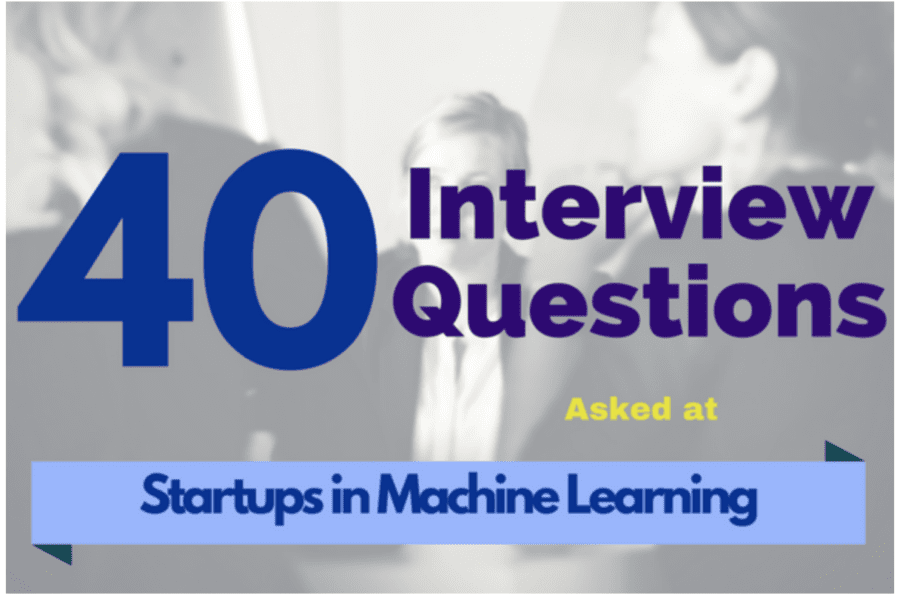This article was posted by Manish Saraswat on Analytics Vidhya. Manish who works in marketing and Data Science at Analytics Vidhya believes that education can change this world. R, Data Science and Machine Learning keep him busy.
Machine learning and data science are being looked as the drivers of the next industrial revolution happening in the world today. This also means that there are numerous exciting startups looking for data scientists. What could be a better start for your aspiring career!
However, still, getting into these roles is not easy. You obviously need to get excited about the idea, team and the vision of the company. You might also find some real difficult techincal questions on your way. The set of questions asked depend on what does the startup do. Do they provide consulting? Do they build ML products ? You should always find this out prior to beginning your interview preparation.
To help you prepare for your next interview, I’ve prepared a list of 40 plausible & tricky questions which are likely to come across your way in interviews. If you can answer and understand these question, rest assured, you will give a tough fight in your job interview.

Interview Questions on Machine Learning:
Q1. You are given a train data set having 1000 columns and 1 million rows. The data set is based on a classification problem. Your manager has asked you to reduce the dimension of this data so that model computation time can be reduced. Your machine has memory constraints. What would you do? (You are free to make practical assumptions.)
Answer: Processing a high dimensional data on a limited memory machine is a strenuous task, your interviewer would be fully aware of that. Following are the methods you can use to tackle such situation:
- Since we have lower RAM, we should close all other applications in our machine, including the web browser, so that most of the memory can be put to use.
- We can randomly sample the data set. This means, we can create a smaller data set, let’s say, having 1000 variables and 300000 rows and do the computations.
- To reduce dimensionality, we can separate the numerical and categorical variables and remove the correlated variables. For numerical variables, we’ll use correlation. For categorical variables, we’ll use chi-square test.
- Also, we can use PCA and pick the components which can explain the maximum variance in the data set.
- We can also apply our business understanding to estimate which all predictors can impact the response variable. But, this is an intuitive approach, failing to identify useful predictors might result in significant loss of information.
Q2. Is rotation necessary in PCA? If yes, Why? What will happen if you don’t rotate the components?
Answer: Yes, rotation (orthogonal) is necessary because it maximizes the difference between variance captured by the component. This makes the components easier to interpret. Not to forget, that’s the motive of doing PCA where, we aim to select fewer components (than features) which can explain the maximum variance in the data set. By doing rotation, the relative location of the components doesn’t change, it only changes the actual coordinates of the points.
If we don’t rotate the components, the effect of PCA will diminish and we’ll have to select more number of components to explain variance in the data set.
Know more: PCA
Q3. You are given a data set. The data set has missing values which spread along 1 standard deviation from the median. What percentage of data would remain unaffected? Why?
Answer: This question has enough hints for you to start thinking! Since, the data is spread across median, let’s assume it’s a normal distribution. We know, in a normal distribution, ~68% of the data lies in 1 standard deviation from mean (or mode, median), which leaves ~32% of the data unaffected. Therefore, ~32% of the data would remain unaffected by missing values.
Q4. You are given a data set on cancer detection. You’ve build a classification model and achieved an accuracy of 96%. Why shouldn’t you be happy with your model performance? What can you do about it?
Answer: If you have worked on enough data sets, you should deduce that cancer detection results in imbalanced data. In an imbalanced data set, accuracy should not be used as a measure of performance because 96% (as given) might only be predicting majority class correctly, but our class of interest is minority class (4%) which is the people who actually got diagnosed with cancer. Hence, in order to evaluate model performance, we should use Sensitivity (True Positive Rate), Specificity (True Negative Rate), F measure to determine class wise performance of the classifier. If the minority class performance is found to to be poor, we can undertake the following steps:
- We can use undersampling, oversampling or SMOTE to make the data balanced.
- We can alter the prediction threshold value by doing probability caliberation and finding a optimal threshold using AUC-ROC curve.
- We can assign weight to classes such that the minority classes gets larger weight.
- We can also use anomaly detection.
Know more: Imbalanced Classification
Q5. Why is naive Bayes so ‘naive’ ?
Answer: naive Bayes is so ‘naive’ because it assumes that all of the features in a data set are equally important and independent. As we know, these assumption are rarely true in real world scenario.
To read the 35 other Interview questions and their answer, click here.
DSC Resources
- Services: Hire a Data Scientist | Search DSC | Classifieds | Find a Job
- Contributors: Post a Blog | Ask a Question
- Follow us: @DataScienceCtrl | @AnalyticBridge
Popular Articles
